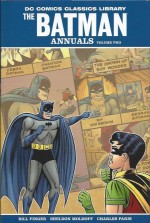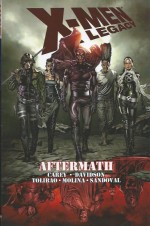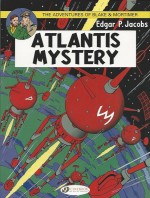
By Bob Kane, Bill Finger, Edmond Hamilton, Jerry Coleman, David Wood, France Herron, Sheldon Moldoff, Lew Sayre Schwartz, Dick Sprang, Curt Swan & various (DC Comics)
ISBN: 978-1-4012-2791-3
There’s a lot of truly splendid 1940s and 1950s comics material around these days in a lot of impressive formats. DC’s Classics Comics Library hardbacks are a remarkably accessible, collectible range of products and one of the best is this wonderful aggregation of four of the most influential and beloved comicbooks of the Silver Age of American comicbooks.
Batman Annual #1 was released in June 1961, a year after the phenomenally successful Superman Annual #1. The big, bold anthology format was hugely popular with readers. The Man of Steel’s second Annual was rushed out before Christmas and the third came out a mere year after the first. That same month the first Secret Origins compilation and the aforementioned Batman Blockbuster all arrived in shops and on newsstands.
It’s probably hard to appreciate now but those huge books – 80 pages instead of 32 and practically no advertising – were a magical resource with a colossal impact for kids who loved comics. I don’t mean the ubiquitous scruffs, oiks and scallywags of school days who read casually then chucked them away (most kids were comics consumers in the days before computer games) but rather those quiet, secretive few of us who treasured and kept them, constantly re-reading, discussing, pondering, even making our own.
Only posh kids with wicked parents read no comics at all: those prissy, starchy types who were beaten up by the scruffs, oiks and scallywags even more than us bookworms. But I digress…
For budding collectors the Annuals were a gateway to a fabulous lost past. Just Imagine!: adventures your heroes had from before you were even born…
Those fantastic innovative aggregations in the early 1960s changed comics publishing. Soon Marvel, Charlton and Archie were also releasing giant books of old stories, then came new ones, crossovers, continued stories…
Annuals proved two things to publishers: that there was a dedicated, long-term appetite for more material – and that punters were willing to pay a little bit more for it…
This hardback compendium gathers Batman Annuals #4-7 from (1963-1966) in their mythic entirety: 33 terrific complete stories, stunning pin-ups and those magnificently iconic compartmentalized covers. Also included are original publication details and credits (the only bad thing about those big books of magic was never knowing “Who†and “Whereâ€â€¦), creator biographies and another reminiscing Introduction from Michael Uslan, putting the entire nostalgic experience into perspective
Way back then the editors sagely packaged Annuals as themed collections, the first here being ‘The Secret Adventures of Batman and Robin’ (released November 8th 1962) which started the ball rolling with ‘The First Batman’ (by Bill Finger & Sheldon Moldoff and originally seen in Detective Comics #235, September 1956): a key story of this period which introduced a strong psychological component to Batman’s origins, disclosing how when Bruce Wayne was still a toddler his father had clashed with gangsters whilst clad in a fancy dress bat costume…
‘Am I Really Batman?’ (Finger, Moldoff & Charles Paris, Batman #112, December 1957) saw bona fide mad scientist Professor Milo poison the hero with a rare plant, forcing Robin and Alfred to put the Masked Manhunter through a baffling psychological ordeal to counteract the toxin…
Today fans are pretty used to a vast battalion of bat-themed champions haunting Gotham City and its troubled environs, but for the longest time it was just Bruce, Dick Grayson and occasionally their borrowed dog Ace keeping crime on the run. However in Detective Comics #233 (July 1956, three months before the debut of the Flash officially ushered in the Silver Age) the editorial powers-that-be introduced bold heiress Kathy Kane, who incessantly suited-up in chiropteran red and yellow for the next eight years.
‘Origin of the Batwoman’ by Edmond Hamilton, Moldoff & Paris premiered with the former circus acrobat bursting into Batman’s life, challenging him to discover her secret identity at the risk of exposing his own…
The Boy Wonder began very publicly working solo after ‘The Vanished Batman’ (Hamilton, Moldoff & Paris or Stan Kaye, from Batman #101, August 1956) saw the Gotham Gangbuster declared dead and presumed gone by the underworld whilst ‘The Phantom of the Bat-Cave’ (Hamilton, Moldoff & Paris, Batman #99, April 1956) offered a genuine mystery as persons unknown began somehow stealing and replacing items from the heroes’ sacrosanct trophy room…
‘Batman’s College Days’ (Finger, Moldoff & Paris, Batman #96, December 1955) found Bruce Wayne on a sea cruise with three fellow alumni, one of whom planned murder and had deduced his alter ego, after which ‘The Marriage of Batman and Batwoman’ (Finger, Moldoff & Ray Burnley, Batman #122, March 1959) depicted Robin’s nightmares should such a nuptial event occur whereas ‘The Second Boy Wonder’ (France Herron, Moldoff & Burnley, Batman #105, February 1957) was all too real as a stranger apparently infiltrated the Batcave by impersonating the kid crimebuster…
The Annual ended with ‘The Man who Ended Batman’s Career’ (Finger, Moldoff & Paris from Detective Comics #247, September 1957) which presented a significantly different-looking Professor Milo using psychological warfare and scientific mind-control to attack the Dark Knight by inducing a fear of bats…
The next Annual, released in summer 1963, highlighted ‘The Strange Lives of Batman and Robin’ and opened with ‘The Power that Doomed Batman’ (Finger, Moldoff & Paris, Detective Comics #268 June 1959) as exposure to a comet gifted the Dark Knight with super-strength. Sadly the effect was also cumulatively fatal and forced the heroes into a desperate hunt for a missing man who possessed a cure…
The same creative team dredged up ‘The Merman Batman’ (Batman #118, September 1958) wherein an lightning strike transformed the Caped crimebuster into a water-breather, aroused ‘Rip Van Batman’ (Batman #119, October 1958) who fell into a plant-induced coma to seemingly awake in the future and corralled ‘The Zebra Batman’ (Detective Comics #275, January 1960) when the hero was turned into an uncontrollable human magnet…
‘The Grown-Up Boy Wonder’ (Finger, Moldoff & Stan Kaye, Batman #107, April 1957) detailed what happens when space gas turned the likely lad into a strapping young man – but only in body, not mind – after which World’s Finest Comics #109, from May 1960, revealed Robin and Superman‘s tense race to save the Gotham Guardian from an ancient curse in ‘The Bewitched Batman’ by Jerry Coleman, Curt Swan & Moldoff.
‘The Phantom Batman’ (Hamilton, Dick Sprang & Paris, Batman #110, September 1957 showed how an electrical mishap reversed the polarity of the Caped Crusader’s atoms, relegating him to helpless intangibility, and the uncanny yarns end with ‘The Giant Batman’ (from Detective Comics #243 May 1957, by the same team and originally entitled “Batman the Giant!â€).
Here the hero was exposed to a well-meaning scientist’s “Maximizer†ray and grew too large to catch the thieves who stole it and the antidote…
Six months later saw publication of Batman Annual #6 (Winter 1963-1964) featuring ‘Batman and Robin’s Most Thrilling Mystery Cases’ which kicked off with ‘Murder at Mystery Castle’ (Finger, Moldoff & Paris, Detective Comics #246 August 1957) as visitors – Batman and Robin included – to a reconstructed medieval fortress witnessed a devilish remote control killing and had to deduce who set the fiendish trap…
‘The Gotham City Safari’ (Finger, Moldoff & Paris Batman #111, October 1957) saw the Dynamic Duo hunting a hidden killer through a fabulous theme-park of exotic locales whilst ‘The Mystery of the Sky Museum’ (Hamilton, Moldoff & Paris, Batman #94, September 1955) found them at an aviation museum on the trail of sinister smugglers.
‘The Mystery of the Four Batmen’ (Hamilton, Sprang & Paris Batman #88, December 1954) was a seagoing enigma with the Partners in Peril seeking a mysterious smuggler with a tenuous connection to bats in one form or another, after which a movie monster made trouble on location, compelling the crimebusting champions to tackle ‘The Creature from the Green Lagoon’ (David Wood, Moldoff & Paris Detective Comics #252 February 1958)…
A stunning chase to expose a killer searching for a lost golden hoard involved solving ‘The Map of Mystery’ (Hamilton, Sprang & Paris, Batman #91, April 1955), whilst a disgruntled family member seemingly threatened to kill every member of ‘The Danger Club’ (Hamilton, Lew Sayre Schwartz & Paris, Batman #76, April/May 1953).
The astounding sleuthing ceases after uncovering ‘Doom in Dinosaur Hall’ (Finger, Moldoff & Paris, Detective Comics #255 May 1958) where the curator’s murder at the Gotham’s Mechanical Museum of Natural History led to a fantastic chase and a surprise culprit…
Summer 1964 produced Batman Annual #7 and ‘Thrilling Adventures of the Whole Batman Family’ beginning with the introduction of the Gotham Guardian’s most controversial “partner†– a pestiferous, prank-playing extra-dimensional elf – in ‘Batman Meets Bat-Mite’ by Finger, Moldoff & Paris from Detective Comics #267 May 1959) after which the eponymous masked dog Ace narrates ‘The Secret Life of Bat-Hound’ (Finger, Moldoff & Paris, Batman #125, August 1959) and his part in capturing the nefarious Midas Gang…
Finger, Moldoff & Paris enlarged the fictitious family in Batman #139 (April 1961), ‘Introducing Bat-Girl’ as Kathy Kane’s niece Betty began dressing up and acting out as her unwanted assistant, eventually proving adults and boys wrong by taking down the deadly King Cobra and his crew, after which Hamilton wrote the only adventure of ‘The Dynamic Trio’ (Detective Comics #245 July 1957), with a very old friend donning cape and cowl as Mysteryman to help combat a smuggling ring facilitating the escape of Gotham’s fugitives.
Courtesy of Finger, Moldoff & Paris, faithful manservant Alfred personally revealed an early failure and its shocking resolution in ‘The Secret of Batman’s Butler’ (Batman #110, September 1957) before ‘The New Team of Superman and Robin’ (Finger, Swan & Moldoff, World’s Finest Comics # 75, March/April 1955) revealed how a disabled Batman could only fret and fume as his erstwhile assistant seemingly dumped him for a better man…
When Bat-Mite elected himself ‘Batwoman’s Publicity Agent’ (Finger & Moldoff, Batman #133, August 1960) the result was naturally chaos and unbridled craziness but not as much as the “Imaginary Story†devised by Alfred debuting ‘The Second Batman and Robin Team’ (Finger, Moldoff & Paris, Batman #131, April 1960) which would inevitably emerge after Bruce and Kathy wed and Dick assumed the mantle of the bat…
Moldoff’s unforgettable back page pin-up ‘Greetings from the Batman Family’ then wraps this final glimpse at simpler, weirder times.
Strange, addictive and still potently engrossing, these weird wonder tales typify a lost time of gentler danger, more wholesome evil and irresistible fun. They’re also impossibly compelling, incredibly illustrated and undeniably influential. A perfect treat for young and old alike.
© 1962, 1963, 2010 DC Comics. All Rights Reserved.











